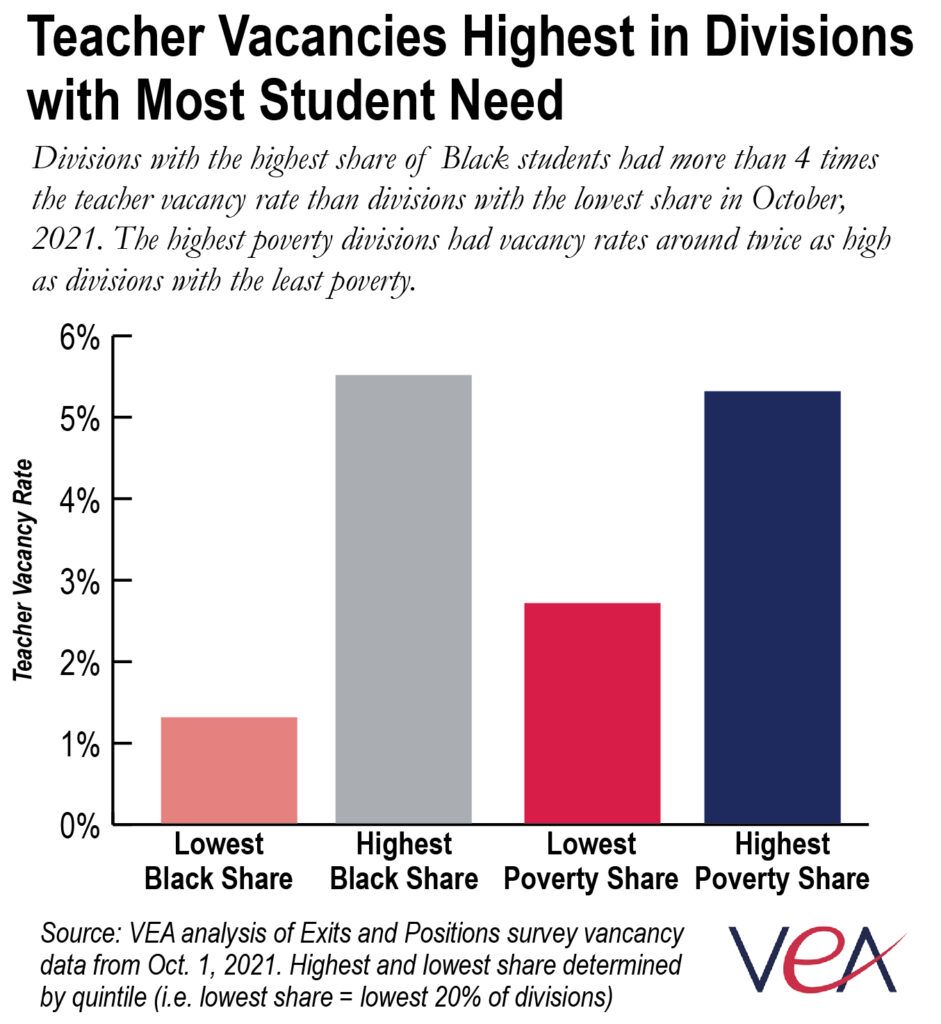New School Staff Vacancy Data Should be a Wake Up Call to State Lawmakers
April 20, 2022
April 20, 2022
We all want our public schools to be places where kids are reliably transported to school in the morning, educated by a full-time certified teacher, served a nutritious meal, and provided supplemental services when needed, such as counseling or special needs. Yet, for too many Virginia students this year, staffing shortages challenged everyday school operations and learning. Worse, according to recently released data by the Virginia Department of Education (VDOE), these staffing shortages were significantly more severe in schools with a high share of Black students, students of color, and students experiencing poverty. As state lawmakers currently deliberate what resources to include in the final budget, they have an opportunity to meaningfully address Virginia’s staffing crisis this year and provide more adequate funding to ensure it doesn’t get worse next year.
Before looking at solutions, it’s important to understand what the data is telling us. This is the first year VDOE released vacancy data with a high level of detail – providing a snapshot of staffing levels October 1, 2021.* Most school divisions had the greatest challenges filling bus driver positions, while others struggled more with administrators and teachers. Several divisions had more than 1 in 10 positions unfilled. Divisions with the highest share of Black students** had nearly three times the staff vacancy rates of divisions with the lowest share (8.2% v.s. 2.5%). The story was similar for schools with the highest share of students of color compared to the lowest share (7.6% v.s. 2.7%). The differences were less pronounced for divisions with the highest share of students experiencing poverty, but still higher than divisions with the lowest share (7.8% v.s. 5.0%).
var divElement = document.getElementById(‘viz1650390345843’); var vizElement = divElement.getElementsByTagName(‘object’)[0]; if ( divElement.offsetWidth > 800 ) { vizElement.style.minWidth=’420px’;vizElement.style.maxWidth=’650px’;vizElement.style.width=’100%’;vizElement.style.minHeight=’587px’;vizElement.style.maxHeight=’887px’;vizElement.style.height=(divElement.offsetWidth*0.75)+’px’;} else if ( divElement.offsetWidth > 500 ) { vizElement.style.minWidth=’420px’;vizElement.style.maxWidth=’650px’;vizElement.style.width=’100%’;vizElement.style.minHeight=’587px’;vizElement.style.maxHeight=’887px’;vizElement.style.height=(divElement.offsetWidth*0.75)+’px’;} else { vizElement.style.width=’100%’;vizElement.style.height=’727px’;} var scriptElement = document.createElement(‘script’); scriptElement.src = ‘https://public.tableau.com/javascripts/api/viz_v1.js’; vizElement.parentNode.insertBefore(scriptElement, vizElement);
In disaggregating the data by teacher vacancies, several concerning trends emerge. Divisions with the highest share of Black students have an average teacher vacancy rate more than four times that of divisions with the lowest share (5.5% v.s. 1.3%). Similarly, divisions with the highest student poverty rates had nearly twice the teacher vacancy rate compared to divisions with the lowest poverty rates (5.3% v.s. 2.7%). The findings are particularly worrying considering the fact that Black and low-income students already faced significant barriers to learning in Virginia before the pandemic, and state testing data indicates these groups lost significant ground over the past two years.

With 90% of teachers reporting burnout according to a recent national survey, and a dwindling supply of people entering teacher preparation programs, without coordinated state-level intervention, we should expect our school staffing crisis to get worse in the coming years. Fortunately, Virginia is a relatively high income state*** and lawmakers have ample options over the long term to stem the staffing crisis. This includes getting serious about investing in ‘grow-your-own’ teacher pipeline programs and making it more affordable to enter the teaching profession, as many other states have done. Virginia has only dabbled in funding a couple small scale teacher residency programs to date. Virginia should also significantly increase its state per pupil spending – currently, Virginia ranks 41st out of all states, hovering between states with far fewer resources like Mississippi and Missouri.
In the near term, state lawmakers who are negotiating the final state budget right now could make several critical investments. Below are the top 5 budget investments that have already been proposed this year and lawmakers could easily include in the final budget to address Virginia’s school staffing crisis:
These solutions are all on the table and state lawmakers have ample funding to fully fund each one. State lawmakers ultimately bear significant responsibility for the trajectory of our school staffing crisis and could be education champions if they meaningfully intervene this year to change Virginia’s course for the better.
*Richmond City Public Schools is the only division excluded from the data analysis since they are currently reviewing their data.
**Divisions defined as having top or lowest shares of types of students are broken up by quintile (i.e. divisions with the highest share of Black students means the top 20% of divisions with the highest share)
***Virginia is a top ten state for median household income according to the most recent Census data.
Virginia is a top 10 state in median household income, but ranks 36th in the US in state per pupil funding of K-12 education.
Learn More